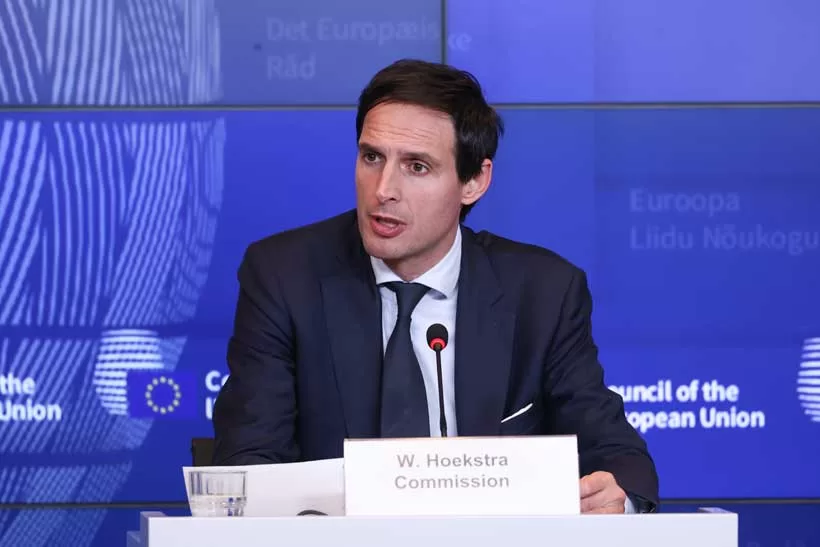Speaking to the Financial Times ahead of the February 6 announcement of a new EU plan for cutting greenhouse gas emissions by 2040, climate commissioner Wopke Hoekstra said that despite “significant worries” from industry, he was “absolutely convinced” Europe could continue to have a “world class, second to none, business environment”. “We need to stand on two legs: one leg is climate action, the other leg is the just transition, competitiveness and a thriving business community, because both are needed,” said the Dutch politician.
The EU should not “be lured into the false narrative that you can only have one or the other”, he added. Brussels intends to propose that the EU should cut emissions by 90 per cent by 2040, compared with 1990 levels, according to drafts of the document seen by the Financial Times.
In 2019, following a wave of green sentiment, the EU set out one of the world’s most ambitious climate policies with its Green Deal climate law. It committed the bloc to reaching net zero emissions by 2050 through a near-total overhaul of its economy. But the picture has since changed dramatically as the bloc battled the repercussions of Covid-19, the war in Ukraine, a gas supply crisis and competition from vast subsidy schemes for clean technologies in the US and China.
The burden of environmental regulation has prompted widespread protests from farmers in France, Germany, Poland, Romania and Belgium in recent weeks, and criticism from rightwing politicians ahead of EU-wide elections in June. Industrialists, still struggling with the effects of 2022’s energy crisis, said EU targets and bureaucracy were holding up investment and innovation.
The 2040 target is intended as a waymarker on the bloc’s path to net zero and a guide to setting an EU-wide Nationally Determined Contribution — the measure by which countries report their efforts on cutting emissions to the UN — for 2035. It must be formally proposed and agreed by the bloc’s 27 governments before becoming law. Countries including Germany, France and Spain have said that they would back an ambitious climate goal for 2040.
But the EU’s scientific advisory board said in a report this month that the bloc needed to more than double its current rate of emissions reductions if it was to meet an existing 55 per cent target by 2030. Such a transformation of the bloc’s economy will require vast investment, the European Commission has said. It estimated that a 90 per cent emissions cut could require investment of €1.5tn annually, according to a draft assessment.
Hoekstra acknowledged that the transition had already inflicted “heavy change” on industries and would continue to do so for the foreseeable future. “That is in both a geopolitical and a business climate that will continue to be uncertain and disruptive,” he said.
Linda Kalcher, executive director of Brussels-based think-tank Strategic Perspectives, said such high levels of investment might “cause concerns and unease in member states”, especially those with smaller economies.
Hoekstra said one of the “most effective” things the bloc could do would be to help other countries create carbon markets akin to the EU’s that forced polluters to pay for their emissions. “It is an illusion to think, as with any global problem, that if you solve it in your own continent you are there,” he said. “If we don’t manage to drive down the other 93 per cent [of emissions], climate change will still happen, because climate change is indiscriminate. It happens north, south, east and west.”
The EU’s climate commissioner tells our correspondent the EU must push ahead with its green agenda despite rising resistance, and my Brussels colleague reports on the promise of medicinal tomatoes being dangled before Europe’s farmers, writes ‘The Financial Times’.
Brussels is due to publish its recommendation for how much the bloc should cut greenhouse gas emissions by 2040 next week. But the European Commission is feeling the heat not only from global warming: businesses and farmers say that the raft of paperwork stemming from its environmental legislation is making it impossible for European industries to compete.
Wopke Hoekstra, the EU’s climate commissioner, said easing off was not an option, in an interview in which he also rebutted claims that green policies erode competitiveness.
Businesses need a “clear horizon”, he said. “The worst thing is to change your goals . . . particularly companies in heavy industry, companies with a very long investment horizon, it helps a lot to have clarity”.
Finding the investment to reach that goal is another matter, however.
The EU’s €800bn Covid-19 recovery fund, financed by common borrowing, provides a significant amount of the public money dedicated to green projects. But it runs out in 2026.
There would, for example, be significant cost savings from the fall in fossil fuel imports.
“Yes there is a price tag but there is also a huge opportunity,” said the Dutch politician.
With farmers on the march across Europe over the cost of going green, the European Commission is deploying a new weapon to win them round: a genetically engineered tomato.
Context: The agriculture industry has been hit by rising costs of fertilisers and pesticides, and falling harvests because of climate change as well as new green regulations. Brussels wants to give them access to new crops that could thrive in droughts or survive high winds.
Japanese professor Hiroshi Ezura, who created the world’s first commercially sold gene-edited fruit, a tomato that can reduce blood pressure, visited Brussels last week to convince lawmakers to press ahead.
The EU has blocked most genetically modified plants because of consumer resistance.
